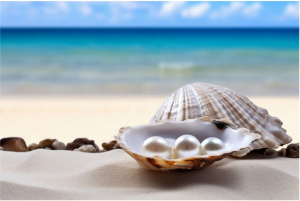
Pearl oyster farming requires a high level of technical expertise and careful attention to various factors to ensure the success and quality of the pearls produced. Below are some key considerations for pearl oyster farming:
1. Selecting the Right Species
- Species Selection: Different species of pearl oysters thrive in different environments, such as freshwater or saltwater. Common saltwater species include Pinctada maxima and Pinctada margaritifera, while freshwater species include Hyriopsis cumingii.
- Regional Suitability: Choose a pearl oyster species that is well-suited to the local climate and water conditions.
2. Optimal Farming Environment
- Water Quality: The water should be clean and free from pollution. Key parameters such as pH, salinity, and dissolved oxygen levels must be maintained within optimal ranges. A water temperature of 18°C to 30°C is generally ideal.
- Water Flow: There should be gentle water movement to provide adequate oxygen and nutrients, but strong currents can damage the oysters.
- Water Depth: The ideal water depth for pearl farming is typically between 2-8 meters, suitable for oyster growth and reproduction.
3. Feeding Management
- Pearl oysters primarily feed on plankton. It’s important to monitor plankton density in the water. If natural food sources are insufficient, supplemental feeding may be necessary.
4. Oyster Maintenance
- Regular Shell Cleaning: Clean the oyster shells regularly to remove algae, sediment, and other debris to ensure healthy growth.
- Adjusting Farming Density: Overcrowded conditions can affect the growth of pearl oysters. Adjusting the density of the oysters will ensure each one has enough space and access to food.
5. Nucleus Implantation
- Skilled Operation: The process of inserting a pearl nucleus is a critical step in pearl farming, requiring skilled hands to ensure the oyster accepts the nucleus and starts forming the pearl.
- Infection Control: The procedure must be performed in a sterile environment to avoid infections, which could kill the oyster or lower the pearl’s quality.
6. Controlling Stock Density
- Proper Stocking: Maintain an appropriate number of oysters per square meter. Overcrowding can stress the oysters and negatively affect their health and pearl production.
7. Disease Prevention and Health Monitoring
- Pearl oysters are prone to bacterial, fungal, and parasitic infections. Regular health checks are crucial.
- Preventive Measures: Regular water changes, maintaining water quality, and the controlled use of antibiotics or treatments can help prevent disease outbreaks.
8. Responding to Environmental Changes
- Temperature Management: Extreme weather conditions, such as cold snaps or heat waves, can affect the health of the oysters. Farmers should be prepared to adjust water temperature or move the oysters to a safer environment.
- Protection from Storms: In coastal regions, pearl farms are vulnerable to typhoons or storm surges, so it’s important to have protective measures in place, such as securing oyster rafts or nets.
9. Timing of Harvest
- Harvest Timing: The harvest period depends on the species and environmental conditions, but pearl oysters are generally ready for harvest after 2-3 years. Harvesting too early or too late can affect pearl quality.
- Gentle Handling: Handle the oysters carefully during harvest to avoid damaging the shells or pearls.
10. Environmental and Legal Compliance
- Environmental Responsibility: Pearl farming should be conducted in an eco-friendly manner to avoid damaging the local marine environment.
- Legal Requirements: Farmers must comply with local regulations regarding aquaculture, environmental protection, and labor practices.
In summary, pearl oyster farming involves careful management of water quality, skilled handling during the nucleus implantation process, disease prevention, and attention to environmental factors. By adhering to these principles, farmers can produce high-quality pearls while maintaining sustainable practices.
